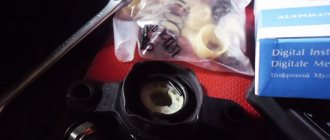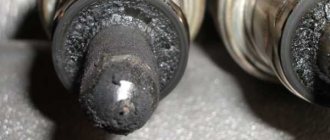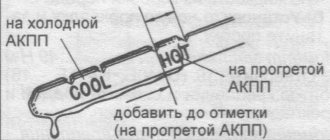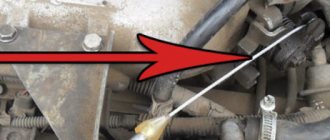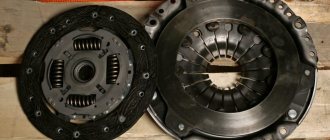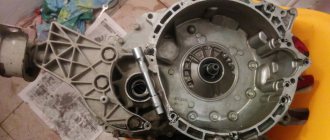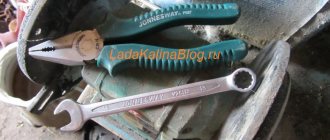Lada Kalina jerks when starting off
Lada Kalina 1.6, 8 cells.
When driving slowly in courtyards, when police are passing, or on roads with potholes. When you press the gas smoothly, the car moves jerkily and jerks. I washed the throttle body, it became a little better, but not for long. The car again began to move jerkily and jerk even more. There are no jerks during acceleration. The dynamics also disappeared, then it appears when there is little gasoline left in the tank, about 5 liters. Then you fill in a new one. You drive a little, the dynamics decrease again. I always fill up at one gas station, mostly.
- VAZ Kalina stalls 2-4 seconds after starting – 6 answers
- Lada Kalina twitches – 3 answers
- Kalina stalls in wet weather - 3 answers
- Kalina takes a long time to start - 3 answers
- Why does Kalina stall when driving? – 2 answers
Looks like a faulty canister valve. But maybe something else. Is the check light on? diagnostics need to be done.
Without voltage - the valve is closed. When 12 volts are supplied, the valve is open.
I tried to attach a video of checking the valve, but it won’t attach, I don’t know why (before I was always able to attach videos).
“A method for determining the malfunction of the adsorber in VAZ cars. After the engine warms up above a temperature of 60 °C, a significant drop in engine speed at idle begins. In addition, your car may suddenly stall while driving for no specific reason.”
Here is a link to a video on checking the valve
Many car enthusiasts have come across the concept of Lada Kalina twitching at low speeds. This malfunction can be associated with different car systems, but not every car owner is able to find this malfunction and fix it.
The video shows an example when an 8-valve engine operates “jerkily”, and what to do about it:
Removal and installation of distributor VAZ-2107, 2104, 2105, 2106
Preparation
Before installing a new VAZ-2107 distributor for a contact ignition system, you need to adjust the gap between the contacts of the breaker. It is more convenient to do this with the device removed from the car. We check the gap with a flat feeler gauge. The value is set from 0.35 to 0.45 mm. In this case, the protrusion of the cam should move the moving contact away from the stationary contact as much as possible. We adjust by slightly loosening the screws, and then tighten them more firmly and check the gap again. Contacts that have worked hard may have a protrusion on one and a depression on the other, which interferes with adjustment. You can get around this problem by grinding off the protrusion with a needle file. It is better not to use sandpaper, because... small particles of abrasive will definitely “eat” into the surface and interfere with the operation of the contacts.
Before removing the old distributor, mark its position relative to the cylinder block with a marker. You also need to accurately mark the position of the moving contact (slider) relative to the body. If all this is not done, the settings will be violated and the engine will not start.
Installation
Having established exactly the same position of the roller in the body on the new distributor, carefully insert it into the hole in the block, slightly turning the roller to align the splines. Having “planted” the device in place by rotating the body relative to the block, we set the approximate advance angle, as on the old distributor. Secure with a washer and nut, but not too tight. Now you need to plug in the high voltage wires. This is easy to do - each contact on the distributor cover has the number of the cylinder to which it needs to be connected. We connect the wire from the ignition coil to the central terminal. The wires should fit tightly, with a slight tension, the protective caps should be pushed all the way down. Don’t get carried away, don’t bend the petals of the wire tips too much, otherwise later, when you try to remove them, you’ll tear off the wires “with their roots”! A wire goes from the contact wire to the “K” terminal of the ignition coil, usually it is green. If your VAZ-2107 is equipped with a contactless ignition system, then you need to connect a connector with three wires. Having plugged it into the socket, check the fit of the wires; it happens that they “crawl out” from their places and the device does not work. Everything is done, the new distributor is installed and ready to go. Let's try to start the engine. Started up? Great, that means everything was done correctly, all that remains is to check and slightly adjust the ignition timing.
Causes of malfunction
General view of the engine
As in any car, in the Lada Kalina, jerking at low speeds is the first sign of a malfunction in one of the systems. Let's look at where the main problems arise:
- The fuel system and its components can cause the problem.
- The ignition system is associated with the fact that the car jerks at low speeds.
- Another reason could be the gearbox.
To more accurately determine the causes of the malfunction, it is worth considering each system and component separately.
Fuel system
The car jerks at low speeds - this may be due to the fact that the engine does not receive enough fuel mixture.
The problem may lie in the fuel system. In this case, you will have to examine several elements that are part of it.
Fuel rail and fuel injectors
Let's look at finding the problem step by step:
- The first place to look for a problem is the fuel rail and injectors . It is the poor condition of this unit that can cause the car to jerk when accelerating.
- The fuel pump, filter and lines can cause the driver to feel slight jolts at low speeds. For diagnostics, you will need to remove the fuel pump from the gas tank housing.
The mesh (strainer) in the fuel pump on a Lada Kalina is clogged
You can diagnose these components and parts yourself or contact a car service center.
Ignition
The ignition system can cause the car to jerk at low speeds. Particular attention should be paid to the ignition switch, in which the contact connections may fail.
A red glow plug removed from the engine
The second reason could be the spark plugs. Their serviceability and contamination can lead to the fact that the car will not only twitch at low speeds, but also work unstably in other ranges. To prevent this from happening, it is necessary to choose spark plugs with the required gap and recommended by the manufacturer.
Transmission
The most unpleasant consequence of the effect may be the gearbox. In this case, you will have to remove the gearbox, change the oil in it and add new oil to the level. And also carry out a complete disassembly of it for diagnostics. Thus, the reasons may be failed synchronizers of 1st and 2nd gears, wear of gears or shafts. Another problem can be bearings that are worn out.
Gearbox disassembled
Of course, you should trust the diagnosis of this unit to professionals at a car service center, but if possible, you can try to fix the malfunction on your own. Ultimately, when all else fails, they will always be happy to see you at the car service center.
Main problems after replacing the clutch
What does the concept of replacing a clutch include? Clutch replacement means complete replacement of the clutch disc. Quite often, after such manipulations, previously non-existent side effects appear.
If you think about this problem, then there are not very many special prerequisites for the emergence of such negative aspects. As practice shows this:
- illiterate work of non-professional craftsmen;
- factory defect of a new spare part;
- incorrect diagnosis of the problem, due to which the wrong elements or not all components requiring repair were replaced. As a rule, after this, hidden defects reveal themselves fully.
In general, the problem of the emergence of new problems and defects in the operation of a car is very complex and individual in each specific case. But there are still common characteristics.
The car jerks when driving after changing the clutch
For example, before the repair work, the car did not pick up speed well, there was slipping, and the clutch pedal began to operate only at the top. All signs of disc wear were also observed. After replacing it, jerking appeared. What could have happened?
The first reason is a factory defect of the new part. Unfortunately, this is a fairly common practice, especially when it comes to non-original spare parts. For the domestic automobile industry, this situation is also quite common. In simple terms, the driven disk is bent. The clutch basket has multi-level pressure paddles, which is why full release occurs incorrectly and the car jerks when driving.
The second reason is an incorrectly adjusted clutch. In this case, we are talking about its absence after the current repair of the car has been carried out. The new part is much larger, so the clutch pedal does not work as expected. At the moment when the car picks up speed, jerking begins, and an unpleasant crunching sound is heard when changing gears.
Reason number three is an unskilled approach to work, not replacing all worn parts. Often the cause of jerking is a very worn flywheel surface. If it is not replaced, the car may slip and move jerkily.
There is a hum or noise after changing the clutch
Very often, after replacing the clutch, noise and other extraneous sounds appear that were not previously observed. What are the reasons for this phenomenon and what to do about it.
- The new release bearing part may have a manufacturing defect or lack lubricant. In this case, extraneous sounds appear precisely at the moment when the driver presses the clutch pedal. It is a mistake to say that bearing noise occurs only when the clutch is disengaged. This is not only incorrect, but also illogical. When switched off, the part bears absolutely no load.
- The clutch basket may have uneven and rough blades. As a rule, spare parts from domestic manufacturers suffer from such defects. It is worth noting that during the grinding process, extraneous noise will gradually disappear. If necessary, the noise can be temporarily eliminated. To do this, the petals are lubricated with lithol.
- It is likely that during the current repairs, the car owner did not pay attention to extraneous sounds, since in the future he himself planned to carry out a technical inspection of the car. But if after repair the sounds do not disappear, you have to think about the reason for their appearance. Also, very often the cause of this problem is the gearbox. When, when squeezing the clutch, an unpleasant sound appears and then gradually subsides, the gearbox shaft bearing is most likely worn out.
- The driven disc may have unevenness and a rough surface. A slightly audible rustling sound will be observed every time the gears are changed. Both parts will rub against each other and the noise will go away.
- The bearing in the crankshaft can make unpleasant sounds. Service station workers must inspect the part. If it is dry, apply lithol or other appropriate lubricant. If a part is very worn, it is better to replace it completely.
Why is there a knocking noise after clutch repair?
Very often the cause of this malfunction is a defect in spare parts. This is especially true for loose damper springs.
Therefore, it is very important, before installing a new part, to inspect it very carefully.
If you hear extraneous sounds, then most likely there is a crack or play in the bushing. This also leads to knocking and noise.
Broken basket petals are a fairly rare cause of extraneous noise, but, unfortunately, this also occurs.
Conclusion
So, finding the reason for the Lada Kalina jerking at low speeds is quite difficult, because the problem may lie in the main systems, therefore, if the car enthusiast is not confident that he can find and fix the problem, then it is better to immediately contact a car service center.
Hi all! A month ago a problem arose: when starting from a stop, the car began to jerk violently, especially when standing in traffic jams for a long time. At first I thought about the clutch, but it didn’t seem to slip and the thought about the clutch disappeared in the rain; when starting off on wet asphalt with grinds, the car literally starts to jump, mainly the right wheel.
Mileage: 48000 km
FakeHeader
Comments 9
That's putting it mildly)))
The clutch basket is at fault. The hottest place is at the engine + gearbox connection. There are traffic jams, you have to constantly work with the clutch, the ferodo disk rubs against the basket at the moment of stopping and starting to move, not only the contact area and the petals heat up, there is simply an uneven pressure of the ferodo disk to the flywheel, so the car jumps when you start
If this happens during an active start from a standstill, then the strut slowly dies. At least that’s what I have, it was the front right pillar that was sentenced. If it just twitches when starting off (as if you were suddenly dropping the clutch), then you need to look at it. Maybe the damper itself is weird, maybe something else. I had both cases)) According to the first one, I will change the struts in any case, according to the second one, they reset the fuel adjustment, retrained it again, and the twitching disappeared. He described this in his blog.
If this happens during an active start from a standstill, then the strut slowly dies. At least that’s what I have, it was the front right pillar that was sentenced. If it just twitches when starting off (as if you were suddenly dropping the clutch), then you need to look at it. Maybe the damper itself is weird, maybe something else. I had both cases)) According to the first one, I will change the struts in any case, according to the second one, they reset the fuel adjustment, retrained it again, and the twitching disappeared. He described this in his blog.
So I’m also leaning towards the stand. When I slip, my right wheel jumps. I noticed it in the winter when I started to slip, following the tracks of a bulldozer in the snow. The right wheel was jumping like crazy(((Now I finally decided to change the struts.
I don’t know how it is with you. but on my first Kalina it was hard to get going in the back; the car was shaking as if the engine was going to fly out. and then one day the clutch cable broke, and after I changed it, the car stopped jerking, and the clutch began to be depressed like a gas pedal)) try to lubricate the clutch cable, check it when you take it off for biting,
When starting off the car the viburnum twitches
Posted by USA » April 26, 2012, 00:47
Well, if you just open it up, it definitely won’t get any worse
Added after 1 minute 42 seconds:
folk method - experienced drivers also told me at one time
Messages: 29 Registered: March 03, 2011, 00:00 From: Nizhnevartovsk Experience: 3 years Car: VAZ 2110
| Rating: 29 |
| Reputation: 0 |
Post by Sanek-86rus » April 26, 2012, 00:49
Messages: 9639 Registered: Jan 21, 2008, 00:00 :
Awards: 1
| Rating: 55 315 |
| Reputation: +93 |
Thanked: 1418 times Thanked: 685 times
Posted by USA » April 26, 2012, 00:52
The discs won’t do anything for sure... well, if the releaser is too early to change, it costs 200 rubles separately for EMNIP. Well, or drive - it whistles - change it... maybe it will roll around. In general, the philosophy of Rashenkar is - don’t get into the car until the knock comes out on its own
| Rating: 6 328 |
| Reputation: +12 |
Thanked: 9 times Thanked: 64 times
Post by bluebird1992 » Apr 26, 2012 00:53
USA Try to release the gas, stick the third one in and move off... if you lightly burn the rims, it won’t twitch (it will get used to it). . on the classics it helps a lot - I’ve changed the clutch more than once, I’ve always done it that way
FakeHeader
Comments 9
That's putting it mildly)))
The clutch basket is at fault. The hottest place is at the engine + gearbox connection. There are traffic jams, you have to constantly work with the clutch, the ferodo disk rubs against the basket at the moment of stopping and starting to move, not only the contact area and the petals heat up, there is simply an uneven pressure of the ferodo disk to the flywheel, so the car jumps when you start
If this happens during an active start from a standstill, then the strut slowly dies. At least that’s what I have, it was the front right pillar that was sentenced. If it just twitches when starting off (as if you were suddenly dropping the clutch), then you need to look at it. Maybe the damper itself is weird, maybe something else. I had both cases)) According to the first one, I will change the struts in any case, according to the second one, they reset the fuel adjustment, retrained it again, and the twitching disappeared. He described this in his blog.
If this happens during an active start from a standstill, then the strut slowly dies. At least that’s what I have, it was the front right pillar that was sentenced. If it just twitches when starting off (as if you were suddenly dropping the clutch), then you need to look at it. Maybe the damper itself is weird, maybe something else. I had both cases)) According to the first one, I will change the struts in any case, according to the second one, they reset the fuel adjustment, retrained it again, and the twitching disappeared. He described this in his blog.
So I’m also leaning towards the stand. When I slip, my right wheel jumps. I noticed it in the winter when I started to slip, following the tracks of a bulldozer in the snow. The right wheel was jumping like crazy(((Now I finally decided to change the struts.
I don’t know how it is with you. but on my first Kalina it was hard to get going in the back; the car was shaking as if the engine was going to fly out. and then one day the clutch cable broke, and after I changed it, the car stopped jerking, and the clutch began to be depressed like a gas pedal)) try to lubricate the clutch cable, check it when you take it off for biting,
Vibration when starting off viburnum
Many car enthusiasts have come across the concept of Lada Kalina twitching at low speeds. This malfunction can be associated with different car systems, but not every car owner is able to find this malfunction and fix it.
The video shows an example when an 8-valve engine operates “jerkily”, and what to do about it:
What's the result?
As you can see, if a car jerks in first gear or a car jerks in second gear, there can be quite a few reasons. If we talk about the transmission, often with manual transmissions and many types of robotic gearboxes, a common cause is a worn clutch (both as a whole and individual elements) or malfunctions in the actuators responsible for the operation of the clutch on a manual transmission.
We also recommend reading the article about what a manual transmission additive is. From this article you will learn about the purpose and features of various additives for manual transmissions, as well as when to optimally use them. In the case of hydromechanical automatic transmissions, diagnostics are greatly complicated by a large number of sensors and the presence of a torque converter, which is a separate element. For this reason, it is recommended to carry out comprehensive computer diagnostics of the automatic transmission, as well as perform a number of tests and checks, which are carried out by experienced automatic transmission repair specialists at specialized service stations.
Finally, we note that if the owner notices that the car begins to jerk in first gear, the car jerks in second speed, etc., it is better not to delay in determining the cause. On the one hand, quick troubleshooting will allow you to avoid more serious problems and costly breakdowns, but on the other hand, jerking and jerking in the first and second gears can cause accidents and other troubles on the road.
Source
Causes of malfunction
General view of the engine
As in any car, in the Lada Kalina, jerking at low speeds is the first sign of a malfunction in one of the systems. Let's look at where the main problems arise:
- The fuel system and its components can cause the problem.
- The ignition system is associated with the fact that the car jerks at low speeds.
- Another reason could be the gearbox.
To more accurately determine the causes of the malfunction, it is worth considering each system and component separately.
Fuel system
The car jerks at low speeds - this may be due to the fact that the engine does not receive enough fuel mixture.
The problem may lie in the fuel system. In this case, you will have to examine several elements that are part of it.
Fuel rail and fuel injectors
Let's look at finding the problem step by step:
- The first place to look for a problem is the fuel rail and injectors . It is the poor condition of this unit that can cause the car to jerk when accelerating.
- The fuel pump, filter and lines can cause the driver to feel slight jolts at low speeds. For diagnostics, you will need to remove the fuel pump from the gas tank housing.
Motor trouble: signs
If the engine starts to stall, the check engine blinks. But the indicator does not always work, so other signs of malfunction must be taken into account. For example:
engine vibration increases. This is very noticeable at idle and cold speeds. If this phenomenon becomes permanent, then one of the cylinders has failed. But such damage occurs gradually, so not everyone detects it in time. This method is used in later stages of breakdown; spark plugs have changed color. If you remove them, you will notice that the head has become dark. This is due to carbon deposits and soot due to the lack of ignition of the mixture. This indicates obvious problems
Even with prolonged use of candles, their color changes slightly, but there is no soot; fuel consumption has increased - you need to immediately pay attention to the engine; The engine has become less powerful, which is noticeable when moving. It operates on three cylinders
Therefore, if at least one fails, the engine does not have enough torque resource; unstable exhaust sound, which is complemented by vibrations in the body; When accelerating or moving evenly, the car began to twitch.
Attention! You need to listen to how the engine works. If it starts to stall at medium or high speeds, then the valves are probably not functioning properly.
One possible reason is an increased gap between them.
If at least one of the listed signs of breakdown appears, immediate action must be taken. If the engine starts up and the check light comes on, blinks and goes out, the driver may face a more complex problem in the near future. Specialists can fix it. In this case, repairs will be labor-intensive and financially costly.
Conclusion
So, finding the reason for the Lada Kalina jerking at low speeds is quite difficult, because the problem may lie in the main systems, therefore, if the car enthusiast is not confident that he can find and fix the problem, then it is better to immediately contact a car service center.
Some owners of Lada Priora, Granta, Kalina or Vesta cars experience vibrations and jerking when starting to move (the car jerks). One of the reasons for this malfunction may be in the clutch. How to act in the event of such cases is indicated in the AvtoVAZ information letter.
Self-check of the car, identification of symptoms
To understand the possible cause of the breakdown, you should clearly identify the symptoms, and based on this, draw some conclusions.
When the car is warmed up to operating temperature, when you press the gas pedal, it begins to “stupid” or twitch slightly, and then when you pick up speed, this problem disappears and the car operates normally.
If this problem occurs only during acceleration, and not, for example, when starting from a standstill, then the reasons will be the same. If the car jerks when starting from a standstill, then this may be a problem with the clutch or basket. If vibration is felt while driving and not only during acceleration, this may indicate a failure of the cushions securing the engine.
You can learn how to replace a timing belt with your own hands from our specialist’s detailed material.
Information letter No. 5-17 dated 01/23/17
When owners of LADA cars of the KALINA, GRANTA, PRIORA, VESTA families, equipped with a 1.6 liter engine and gearboxes 2180/2181/2182, complained about “Vibrations, jerking when starting the car”
Carry out diagnostics according to the attached methodology, Appendix 1.
If you need to replace the clutch kit:
- If the vehicle is equipped with a driven clutch disc 21703-1601130-30
, in the absence of violation of operating rules, replace the clutch kit under warranty with: pressure plate
21703-1601085-30
, driven disc
21703-1601130-31
; - If the vehicle is equipped with a driven clutch disc 21703-1601130-31
(standard installed only on LADA VESTA GFL120 (KP 21827) vehicles) or a driven clutch disc
21703-1601130-32
(standard installed only on LADA VESTA vehicles GFL110 (KP 21807)) it is necessary to draw up a CLO with a description of the work performed and act in accordance with the recommendations received in response to the CLO.
Fill out the AGO for the work performed with a description of the reasons for the non-compliance and using the defect code, 1601130-051-001 “Vibration, jerking when starting a car with AMT”
, with attachment of a photo of error codes or 0
“Vehicle vibration when starting off”
, depending on the vehicle configuration, defective part 1601130, labor intensity item in accordance with the current collection of labor intensity.
Diesel engines
If there are signs of uneven acceleration, the worst failure for diesel engines is turbine failure, since both the part itself and its replacement are expensive. Typically, symptoms of compressor failure are not sudden. And the later they are identified and eliminated, the more expensive the repairs will be. Therefore, it is important to remember that turbocharger defects must be repaired in a timely manner. Main signs of impending failure:
- turbine whistle;
- blue or black smoke from the chimney;
- loss of power during uniform movement or acceleration.
It is also not uncommon for the turbine pressure sensor to fail, which is why air compression may not meet the engine’s needs. This is an inexpensive part that can be replaced using an amateur tool.
More common causes of jerky driving are leaks in the vacuum hoses. These black, inconspicuous tubes have a big impact on the performance of the diesel engine. If damage or ruptures can be detected, restoring the seal yourself will not be difficult.
It can be said that most causes of jerking in both diesel and gasoline cars can be eliminated and even prevented by regular maintenance. Often this is simply the result of dirt or worn parts. Other causes occur less frequently and are best eliminated in specialized workshops.
Diagnostic technique
Methodology for diagnosing a car and eliminating the defect notes “Vibration, jerking when starting the car”:
1.
Test drive to confirm the defect. Is the defect confirmed?
- YES - go to step 2:
- NO - no repair work is required.
2.
Checking for the presence of fault codes in the ECM and KURKP. Are there any fault codes?
- YES - eliminate the causes of their occurrence in accordance with the relevant technical specifications, and then proceed to step 1;
- NO - go to step 3.
3.
Are there any comments on the stability of the engine at idle and low speeds?
- YES - eliminate the comment and go to step 1;
- NO - go to step 4.
4.
Are there any leaks of working fluids (oil, coolant) in the gearbox area? Was there a risk of getting caught in the clutch?
- YES - eliminate the causes of their occurrence and go to step 5;
- NO - go to step 6.
5.
Remove the clutch. Are there any signs of oil and/or coolant on the clutch friction surfaces?
- YES - replace the clutch kit and wipe the flywheel with acetone/degreaser to remove oil and/or coolant;
- NO - go to step 6.
6.
Are there any damage to the power unit mounts?
- YES - eliminate the comments and go to step 1;
- NO - go to step 7.
7.
Are the tightening torques of the power unit mounting bolts adequate?
- YES - go to step 8;
- NO - reach the required values and go to step 1.
8.
Are the tightening torques of the bolts of the belt securing the gearbox to the engine maintained?
- YES - if there are no violations of the operating rules, replace the clutch kit;
- NO - reach the required values and go to step 1.
Note: the most obvious starting mode in which vibration appears is smooth starting on small slopes. At the same time, when starting, you must not allow the engine speed to drop below idle speed.
Let us remind you that you can determine which transmission is installed on a Lada Vesta car by the values from the fourth digit of the VIN code (GFL11 - VAZ manual transmission; GFL12 - AMT; GFL13 - Renault manual transmission).
By the way, we have already described how the clutch is replaced under warranty, as well as other AvtoVAZ regulations.
My Pepelats rattles a lot when starting. And I'm crazy. Extraneous sounds when driving a car annoy me. Previously, before Pepelats, I had a Shaha (VAZ 2106) produced in 1982, older than me, bitch! So she didn’t make me nervous at all in the salon! Nothing! Nothing was hanging out, shaking, ringing, rattling, or knocking in the cabin.
I divided the problem into 2 parts and made the corresponding observations.
Part 1 of the problem: what is rattling?
Everything that is not firmly fixed rattles. The metal bracelet of my watch on my hand rattles if I hold the steering wheel tightly with this hand. The glass in the doors rattles, especially if they are slightly open. The window lift mechanisms in the front doors rattle (I noticed this when I drove without door trims). The junk in the trunk rattles. The torpedo rattles.
Part 2 of the problem: why is it rattling?
I tried different ways to get going. Either lower the revolutions and gently release the clutch pedal, then more revolutions and release the pedal more sharply. I discovered that Pepelats stops rattling only in some average starting mode: when I give the throttle about 1.5-2 thousand revolutions and smoothly release the clutch pedal, lightly holding it with my foot at the clutch point. But I can’t get used to this starting mode. I tried, but I couldn’t relearn. I start off quite quickly.
1. I stuffed the D-shaped rubber seal inside the door seals. It became better, the windows began to sway less, especially the rear ones. 2. I replaced the velvet covers, thinking that the new ones would hold the glass stronger. Indeed, the new velvet covers pinched the windows so much that the window regulators almost farted and failed. I had to spray the glass with silicone for the first time until the marigolds settled down and drive like a hedgehog in a muddy fog. The result, if there is any, is quite insignificant. And with the windows lowered, they rattle just as much. 3. I covered all the surfaces inside all the doors with vibration and noise. There is a result in terms of sound insulation, but in terms of rattling - no. After all, this procedure did not make the window lift mechanism stay in the door any better.
Question. Has anyone encountered a similar problem? Maybe it's the clutch? I don’t know when and how the previous owner of Pepelats changed the clutch. I don’t know if she changed it at all, or if it’s original (hardly, of course. Although, why not run the original clutch for 62 thousand with the first owner and another 17 thousand with me?)
Dips when pressing the gas pedal - injector
To determine the reasons for the failure of the gas pedal of a raspberry with an injection engine, special equipment is needed, with the help of which diagnostics are carried out. Therefore, to detect a malfunction, you should definitely contact a car service in Moscow.
For the most part, jerking occurs when the fuel supply pressure is low or due to problems with the throttle position sensor.
The pedal falls when the car starts to move
All unpleasant sensations are most often associated with a delayed reaction of the motor to pressing the pedal. Engine stalling often occurs.
The shocks appear when the throttle valve opens, then the sensor gives a signal and the ECU determines at what time to switch from idle to load mode, as well as how much to increase the fuel supply through the injectors. If the pressure is not as high as we would like, and if the injection time is increased, then there will not be enough fuel to move the car.
Also, the cause of jerking may be problems with the electromechanical part of the unit and due to clogging with waste.
Pedal slip during acceleration
Too low fuel supply pressure is the cause of pedal failure during acceleration. Failure can also occur with an automatic transmission due to a lack of working fluid or due to a faulty gearbox.
A car with an automatic transmission accelerates jerkily during its first trip after connecting the battery. This is normal, after a couple of overclocks everything will return to normal.
Dips when pressing the gas pedal on the injector:
The pedal falls when the movement is set
The cause may be a faulty ignition. In this case, diagnostics and repair work are required.
Find out 5 simple ways to avoid being deceived at a car service center. Click on any of the messengers below

